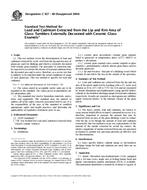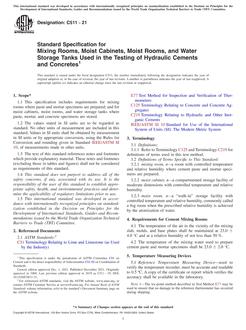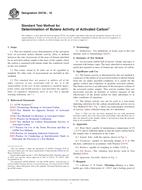1.1 This test method employs an FTIR gas analysis system for the determination of trace impurities in gaseous hydrogen fuels relative to the hydrogen fuel quality limits described in SAE TIR J2719 (April 2008) or in hydrogen fuel quality standards from other governing bodies. This FTIR method is used to quantify gas phase concentrations of multiple target contaminants in hydrogen fuel either directly at the fueling station or on an extracted sample that is sent to be analyzed elsewhere. Multiple contaminants can be measured simultaneously as long as they are in the gaseous phase and absorb in the infrared wavelength region. The detection limits as well as specific target contaminants for this standard were selected based upon those set forth in SAE TIR J2719.
1.2 This test method allows the tester to determine which specific contaminants for hydrogen fuel impurities that are in the gaseous phase and are active infrared absorbers which meet or exceed the detection limits set by SAE TIR J2719 for their particular FTIR instrument. Specific target contaminants include, but are not limited to, ammonia, carbon monoxide, carbon dioxide, formaldehyde, formic acid, methane, ethane, ethylene, propane and water. This test method may be extended to other impurities provided that they are in the gaseous phase or can be vaporized and are active infrared absorbers.
1.3 This test method is intended for analysis of hydrogen fuels used for fuel cell feed gases or for internal combustion engine fuels. This method may also be extended to the analysis of high purity hydrogen gas used for other applications including industrial applications, provided that target impurities and required limits are also identified.
1.4 This test method can be used to analyze hydrogen fuel sampled directly at the point-of-use from fueling station nozzles or other feed gas sources. The sampling apparatus includes a pressure regulator and metering valve to provide an appropriate gas stream for direct analysis by the FTIR spectrometer.
1.5 This test method can also be used to analyze samples captured in storage vessels from point-of-use or other sources. Analysis of the stored samples can be performed either in a mobile laboratory near the sample source or in a standard analytical laboratory.
1.6 A test plan should be prepared that includes (1) the specific impurity species to be measured, (2) the concentration limits for each impurity species, (3) the determination of the minimum detectable concentration for each impurity species as measured on the apparatus before testing.
1.7 The values stated in SI units are to be regarded as standard. No other units of measurement are included in this standard.
1.7.1 Exception – All values are based upon common terms used in the industry of those particular values and when not consistent with SI units, the appropriate SI unit will be included in parenthesis after the common value usage. (4.4, 7.8, 7.9, 10.5, and 11.6)
1.8 This standard does not purport to address all of the safety concerns, if any, associated with its use. It is the responsibility of the user of this standard to establish appropriate safety and health practices and determine the applicability of regulatory limitations prior to use.
Product Details
- Published:
- 09/01/2010
- Number of Pages:
- 13
- File Size:
- 1 file , 260 KB


